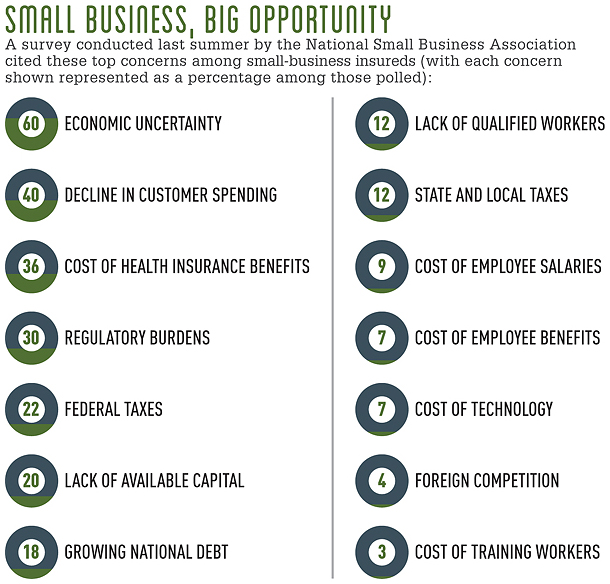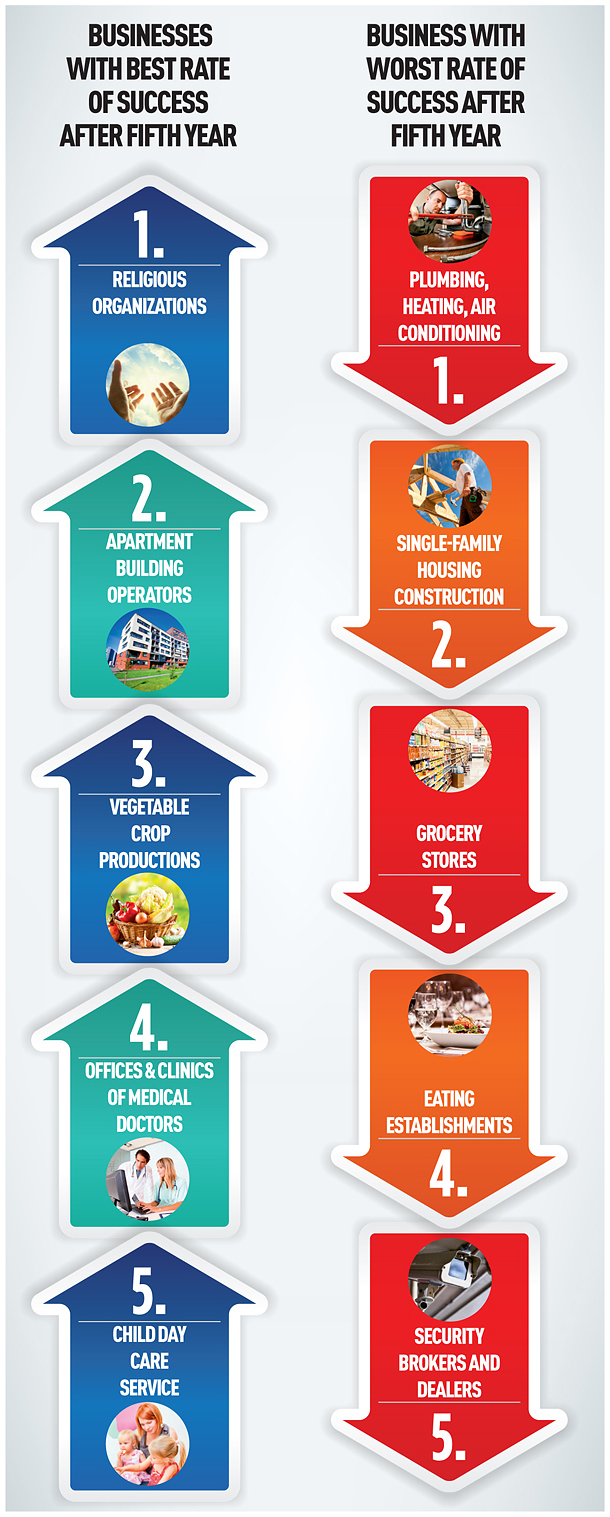 In a sign that the U.S. economy is on the(gradual) upswing, the entrepreneurial rate in the U.S. is nowhigher than it was at the height of the dotcom bubble of 15 yearsago, according to the Kaufman Index of Entrepreneurial Activity(KIEA)—which currently lists more than 20 million non-employerbusinesses, with more starting every day.
In a sign that the U.S. economy is on the(gradual) upswing, the entrepreneurial rate in the U.S. is nowhigher than it was at the height of the dotcom bubble of 15 yearsago, according to the Kaufman Index of Entrepreneurial Activity(KIEA)—which currently lists more than 20 million non-employerbusinesses, with more starting every day.
As defined by the Census Bureau, non-employer businesses have nopaid employees, annual receipts of at least $1,000, and are subjectto federal income taxes. These new businesses can range frompart-time consultants to billion-dollar start-ups backed by bigprivate-equity money.
|But no matter the size of the business, the journey tosuccessful entrepreneurship can be treacherous. According to theU.S. Census Bureau, 16% of companies fail their first year ofoperation, and 32% fail within their first three years (see chart,p. 42). Most of those failures are due to incompetence and lack ofexperience, according to a January 2014 study in EntrepreneurWeekly by the Small Business Development Center at BradleyUniversity and University of Tennessee Research.
|Based on a series of national symposia for agents and insuredshosted by the Travelers Institute, the public policy division ofTravelers Insurance, small businesses' top issues are regulatoryconcerns; licensing and OSHA compliance; health care; access tocapital; and disaster and business continuity planning.
|“Small businesses are hard to run and insurance products can belife or death for them,” says Joan Woodward, president of theTravelers Institute and executive vice president of public policyat Travelers. “Our agents are trying to raise their awareness ofthat.”
|But although most start-up business owners understand the needfor basic coverage, most underestimate how just one cyber breach,natural disaster or nuisance employment lawsuit could decimatetheir businesses.
|“Most small-business owners think insurance is something theycan put off until they get bigger,” says Tom Hammond, executivevice president of Farmington, Conn.-based Bolt Insurance Agency,which targets home-based businesses with 25 employees or fewer.“What becomes valuable is when you can explain coverage and matchit with a price point that makes sense to them. We're sellingpolicies for between $300 and $700 all the time. When you tellsomeone what the coverage provides, most owners know it makes senseto buy if they have the exposure.”
|SPOTTING THE INDICATORS
|Although government initiatives like Startup America and the2012 JOBS Act provide small businesses with additional support andeasier access to capital, most insurance experts working withstart-ups have not seen a correlation between the programs and newcompanies seeking insurance.
Rather, market supply and demand is the biggest driver of newbusiness ventures, which are directly tied to the economic activityin a particular area—whether it's a town, city, state or region,says Mike Berry, CEO of Specialty Insurance Managers, an Austin,Texas-based managing general agency. In his region, that means biggrowth in the oil and gas industry: These businesses attract newemployees, around whom supporting businesses like new hotels,restaurants, convenience stores and health clinics spring up, whichin turn spur new venture business.
|Start-up businesses always have been a staple in theexcess/surplus insurance market because standard insurers preferinsureds with a minimum of three years in business, says RogerWare, CEO of Genesee General, an MGA/wholesaler based inAlpharetta, Ga. Although 40% of Genesee's business is start-ups, hesays, “we didn't target it; it's always been there. We've justtaken advantage of it.”
|Ware has seen an increase in start-ups beginning in about 2011,along with growing sales and payrolls of existing accounts,especially in construction—all of which points to a reboundingeconomy. “From 2007 from 2010, [that activity] was nonexistent,” hesays. Ware spotted the recession as far back as 2007 by shifts inthe trucking industry, which he calls the “biggest indicator on theeconomy.” Transportation insurance requires filings on the numberof units (trucks) a business operates, so when Ware began seeingtrucking accounts going from 30 units to three, he knew trouble wascoming.
|Today, the pendulum is swinging in the other direction. Case inpoint: Genesee had an industrial painting firm client with 30 yearsin business and $100 million in sales that went out of businessduring the recession, taking a number of subcontractors along withit. Today, that same painting firm is relaunching as a newbusiness.
|Average premiums for start-ups are 25% to 30% higher than thestandard market—which translates into higher premiums for agents,Ware notes. The downside is lower retention rates when thosebusinesses either leave for the standard market or simply don'tsurvive.
|THE EDUCATIONAL HURDLE
|Small start-ups need more than just insurance. Because theowners wear many hats and can't afford internal risk managers, theyneed a hands-on insurance agent who can act as a resource to helpestablish formal safety programs and other risk management tools,says Linc Trimble, executive vice president, Torus eCommerce, atTorus Insurance. The needs are different for midsized and largerstart-ups, which require customized solutions and more detailedevaluations, he adds. Basic coverage for a small start-up can be assimple as a BOP policy, or stand-alone general liability andproperty coverages, commercial auto and workers' compensation.
|
However, insurance requirements for new businesses can vary bystate or class of business, so agents should know the laws andregulations for the type of business being underwritten, saysKenneth LaBelle, broker at Burns & Wilcox. States andmunicipalities often require health care or recreation businessesto have proof of insurance before they are issued a permit tooperate, he adds.
|New businesses of any size face exposures that aren't coveredunder the basics, including environmental liability, professionalliability, D&O, employment practices liability, fiduciaryliability, cyber liability, employee dishonesty, media liabilityand international travel, says Maura Verrone, vicepresident/underwriting for ACE Commercial Risk Services. Some ofthese policies may offer overlapping or limited coverage, which cancause more problems for small-business owners.
|Yet educating small start-up owners about the importance of thiscoverage can be frustrating. “We sell and recommend E&O, EPLIand cyber liability, but they don't buy it,” Ware says. “Many havegone from the private sector to consulting and are now independentcontractors, such as construction managers. They have hugeprofessional liability exposures, but they're not asking for that.Agents explain it, but it doesn't sink in. There's never an issueuntil there's a claim.”
|Particularly for new small businesses, such losses can becatastrophic. “Start-ups face similar risks as establishedbusinesses, but the potential impact of any claim is much moredevastating for a start-up that hasn't generated much revenue yet,”LaBelle says. “The defense costs for one frivolous employmentpractice liability claim could potentially wipe out a new business'cash reserve, which is crucial to its survival. So it's importantto work with a retail agent to ensure adequate and comprehensivecoverage for all risk exposures.”
|THE INDEPENDENT-AGENT ADVANTAGE
| Like most lines of business, direct writershave made inroads into the start-up specialty, although they onlycontrol about 4% of the market, says Hammond at Bolt. Part of thereason is because of the variance in types of businesses insured.“No direct writer has a product that can span from a managementconsultant down to a contractor or carpenter,” he points out. “Theproduct needs to be diverse.”
Like most lines of business, direct writershave made inroads into the start-up specialty, although they onlycontrol about 4% of the market, says Hammond at Bolt. Part of thereason is because of the variance in types of businesses insured.“No direct writer has a product that can span from a managementconsultant down to a contractor or carpenter,” he points out. “Theproduct needs to be diverse.”
Bolt partners with direct writers to underwrite start-upbusinesses. “We've seen partnerships with direct writers as beingvery valuable to us because we're able to take any business theycan't write and fill that gap and maintain their brand,” Hammondsays.
|On the whole, however, independent agents deliver more bang forthe buck, including access to multiple carriers in various industrygroups in both the standard and wholesale marketplace; a grasp ofthe complex nature of insurance as applied to each individualbusiness; and understanding of regulatory requirements, saysTrimble.
|Independent agents and small business have a long history ofdoing business with each other, Woodward says: “Agents offer'concierge services' that are critically important for smallbusinesses, and bring years of experience; they have seen it all,every type of claim. Small businesses need that expertise andunderstanding of problems before they happen.”
|There are big benefits for agents, too: a portfolio of smallerrisks lessens the notion of only working with a handful of largeraccounts, Trimble points out. Smaller businesses are also lesssubject to market volatility, and their need to use an agent forrisk management functions adds to the strength of therelationship.
|Knowing your client's business is especially important forstart-ups because in many cases you'll be acting as risk manager,disaster planner and main mitigation advisor, says Ware. “Know yourrisks and coverages,” he advises.
|It's also important to protect yourself, Ware adds: “Retailagents must understand their business and act as their consultant,but if they choose not to buy what you recommend, for God's sake,get it signed off on.”
Want to continue reading?
Become a Free PropertyCasualty360 Digital Reader
Your access to unlimited PropertyCasualty360 content isn’t changing.
Once you are an ALM digital member, you’ll receive:
- All PropertyCasualty360.com news coverage, best practices, and in-depth analysis.
- Educational webcasts, resources from industry leaders, and informative newsletters.
- Other award-winning websites including BenefitsPRO.com and ThinkAdvisor.com.
Already have an account? Sign In
© 2024 ALM Global, LLC, All Rights Reserved. Request academic re-use from www.copyright.com. All other uses, submit a request to [email protected]. For more information visit Asset & Logo Licensing.








